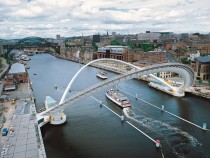
© Graeme Peacock
In a world in which physical systems of communication such as roads, railways, canals, rivers, etc. are used ever more intensively, bridges are vital in allowing one mode of transport to cross another. In that respect, they obviously create links. Less apparent, however, is the fact that they can also create obstacles, in which case they need to be designed in a movable form. Which of the various transport systems may be interrupted will depend on the flexibility of the routing and the loss of time that is acceptable in such a situation. That is why shipping usually has priority at points of intersection, while pedestrian, road and rail traffic can be briefly interrupted at a movable bridge.
In designing bridges of this kind, safety is, of course, the most important aspect, followed by the matter of reliability in maintaining the flow of traffic. Questions of this kind influence the technical planning of the structure, the choice of movement mechanism and the appearance of the construction. Selecting an optimal system of movement for a particular situation is a vital factor and should be based on objective criteria and not just on creating a dramatic effect. Simple technical mechanisms do not necessarily result in run-of-the-mill of solutions, however. There are numerous examples of spectacular bridges based on relatively simple mechanical systems. (Martin Knight, Bartlomiej Halaczek)
In designing bridges of this kind, safety is, of course, the most important aspect, followed by the matter of reliability in maintaining the flow of traffic. Questions of this kind influence the technical planning of the structure, the choice of movement mechanism and the appearance of the construction. Selecting an optimal system of movement for a particular situation is a vital factor and should be based on objective criteria and not just on creating a dramatic effect. Simple technical mechanisms do not necessarily result in run-of-the-mill of solutions, however. There are numerous examples of spectacular bridges based on relatively simple mechanical systems. (Martin Knight, Bartlomiej Halaczek)












